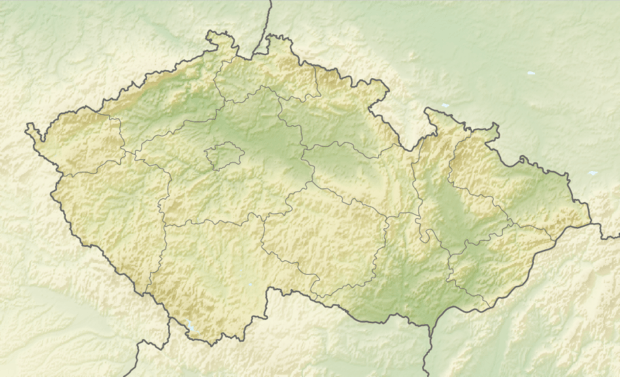Rabí Castle
Rabí or Rábí is a ruined castle in Southwestern Bohemia (Plzeň Region), on a prominent hill by the central course of the River Otava, in the foothills of Šumava region, 130 kilometres (81 mi) from Prague, Czech Republic. It is the largest castle (in terms of area) from all Czech castles. Its name might derive from the German word raben ("raven"), or it could be mangled Czech name vrab(č)í vrch ("sparrow's peak").[1][N 1]
| Rabí | |
|---|---|
| Klatovy, Plzeň Region | |
Rábí Castle | |
 Rabí Location in the Czech Republic | |
| Coordinates | 49°16′45.94″N 13°37′5.23″E |
| Type | Castle |
Rabí Castle was proclaimed a National Cultural Monument in 1978.
History
The first mention of Rábí Castle dates from 1380,[1] although it is not known exactly when it was founded. It is likely that the Lords of Velhartice established it after 1300 to protect trade routes along the Otava and also to inspect gold-bearing deposits in it.[N 2] They built a strong palace, ramparts and a keep. Subsequent owners, the Švihovský of Rýzmburk family, continued building work and built the outer ward and two square towers.
At the start of the Hussite rebellions, the Švihovský family searched for havens of supporters of the Catholic side in the district and for their treasures, at Rábí. In 1420–21, the Hussites conquered the castle twice,[2] and legend has it that during the second siege an arrow fired from crossbow hit the trunk of a pear tree and a resulting splinter from the tree hit Jan Žižka in his only good eye.[3] In 1479, the provincial governor Půta Švihovský of Rýzmberk became the owner of the estate and began with a thoughtful remodelling of the castle under the guidance of famous master Benedict Rejt. New living quarters and service buildings were constructed, the castle was enlarged and the fortifications heightened.
Rabí Castle was, from the very start, envisioned as a donjon-type castle. It was built in the form of three separate sections, constructed in tiers above each other. The ramparts were up to 6 metres (20 ft) wide, and had bastions, vallum fortifications and moats. However, building activity exhausted the Švihovský family's finances and the fortifications remained incomplete.

Many alchemical experiences took place during Půta's time as well; a German alchemist who failed to transform lead into gold was then imprisoned in the castle's massive prismatic tower.[2] Půta had three nannies walled-in alive for turning his wife against his brothers.[2] His son later sold the estate in 1549, but the new owners did not invest in the castle. Instead they made use exclusively of the existing original buildings. The following owners, the House of Chanov, from Dlouhá Ves, bought the castle in 1570.[4]
The slowly deteriorating complex was completely devastated during the Thirty Years' War, when Mansfeld's soldiers went on the rampage. Emperor Ferdinand III ordered that the castle should have been destroyed after 1650.[5] In the end it was saved, but on the condition that it was not to be repaired. In time it became a source of building material for local peasants.
The last owners, the Lamberk family (from 1708) donated the castle to the Horažďovice Society for the Preservation of Artistic, Cultural and Natural Monuments for a symbolic price of 1 Kč in 1920, and after 1945 it was taken by the Czechoslovak State.
See also
Notes
- Czech scholar Michal Novák points that one possible explanation would be that the name probably stems from the German word raben, which means "raven", or it could also suggest something like "Raven's Peak". Another explanation lies in the expression Rabiri, vernacular form of "gold-surveyors", and a third that might be a derivation from vrabec, a bird's name.
- Novak points out a theory which suggests that the castle was commissioned by Bavarian princes when the whole Sušice region was under Bavarian rule, although earlier opposing views state that the castle was only built in the 14th century, constructed by the Lords of Velhartice who had estates nearby.
References
- Velinger, Jan (3 March 2004). "Rabi Castle: some facts and legends surrounding the Czech Republic's most majestic ruins". Český rozhlas. Retrieved 26 September 2010.
- PetrDavid, Vladimír Soukup, Lubomír Čech, Wonders of Bohemia, Moravia and Silesia, Euromedia Group, p. 110. ISBN 978-80-242-2455-8
- Kohl, Johann Georg (2008), Austria, Vienna, Hungary, Bohemia and the Danube, Galicia, Styria, Moravia, and the Military Frontier, Kessinger Publishing, LLC. p. 74. ISBN 1-4370-1183-7
- Městský úřad Sušice. "Rabi Castle". ŠumavaNet.CZ. Retrieved 26 September 2010.
- Ehrenberger, Tomaš (2003), The 88 Most Beautiful Castles, Kartografie Praha a.s., pp. 116. ISBN 80-7011-745-1
External links

- Sušice Brána Šumavy Panoramic views of Rábí Castle.